Impact of COVID-19 Pandemic on the Overall Diagnostic and Therapeutic Process for Patients of Emergency Department and Those with Acute Cerebrovascular Disease
Abstract
1. Introduction
2. Methods
2.1. Data Collection
2.2. Indication of COVID-19 PCR Test
2.3. Selection of Presumed Acute Cerebrovascular Patients
2.4. Data Extraction and Preparation
2.5. Process Mining
2.6. Interpretation
2.7. Statistical Analysis
2.8. Propensity Score Matching
3. Results
3.1. Basic Characteristics
3.2. Outcome
3.3. Process Changes in Overall Patients
3.4. Process Changes in Acute Cerebrovascular Patients
3.5. Propensity Score Matching
4. Discussion
Limitation
Supplementary Materials
Author Contributions
Funding
Conflicts of Interest
References
- Welfare, W.; Wright, E. Planning for the unexpected: Ebola virus, Zika virus, what’s next? Br. J. Hosp. Med. 2016, 77, 704–707. [Google Scholar] [CrossRef] [PubMed]
- Morse, S.S.; Mazet, J.A.K.; Woolhouse, M.; Parrish, C.R.; Carroll, D.; Karesh, W.B.; Zambrana-Torrelio, C.; Lipkin, W.I.; Daszak, P. Prediction and prevention of the next pandemic zoonosis. Lancet 2012, 380, 1956–1965. [Google Scholar] [CrossRef]
- Scarfone, R.J.; Coffin, S.; Fieldston, E.S.; Falkowski, G.; Cooney, M.G.; Grenfell, S. Hospital-based pandemic influenza preparedness and response: Strategies to increase surge capacity. Pediatr. Emerg. Care 2011, 27, 565–572. [Google Scholar] [CrossRef] [PubMed]
- Kollek, D. Response of a community hospital and its emergency department to the H1N1 pandemic influenza. Radiat. Prot. Dosim. 2010, 142, 12–16. [Google Scholar] [CrossRef] [PubMed]
- Singer, A.; Jr, H.C.T.; Viccellio, P.; Pines, J.M. The Association Between Length of Emergency Department Boarding and Mortality. Acad. Emerg. Med. 2011, 18, 1324–1329. [Google Scholar] [CrossRef]
- Morley, C.; Unwin, M.; Peterson, G.M.; Stankovich, J.; Kinsman, L. Emergency department crowding: A systematic review of causes, consequences and solutions. PLoS ONE 2018, 13, e0203316. [Google Scholar] [CrossRef]
- Ackroyd-Stolarz, S.; Guernsey, J.R.; MacKinnon, N.J.; Kovacs, G. The association between a prolonged stay in the emergency department and adverse events in older patients admitted to hospital: A retrospective cohort study. BMJ Qual. Saf. 2011, 20, 564–569. [Google Scholar] [CrossRef]
- McCarthy, M.L.; Zeger, S.L.; Ding, R.; Levin, S.R.; Desmond, J.S.; Lee, J.; Aronsky, D. Crowding Delays Treatment and Lengthens Emergency Department Length of Stay, Even Among High-Acuity Patients. Ann. Emerg. Med. 2009, 54, 492–503.e4. [Google Scholar] [CrossRef]
- Kim, J.-S.; Seo, D.W.; Kim, Y.-J.; Jeong, J.; Kang, H.; Han, K.S.; Kim, S.J.; Lee, S.W.; Ahn, S.; Kim, W.Y. Prolonged Length of Stay in the Emergency Department and Increased Risk of In-Hospital Cardiac Arrest: A nationwide Population-Based Study in South Korea, 2016–2017. J. Clin. Med. 2020, 9, 2284. [Google Scholar] [CrossRef]
- Tomandl, B.F.; Klotz, E.; Handschu, R.; Stemper, B.; Reinhardt, F.; Huk, W.J.; Eberhardt, K.; Fateh-Moghadam, S. Comprehensive Imaging of Ischemic Stroke with Multisection CT. Radiographics 2003, 23, 565–592. [Google Scholar] [CrossRef]
- O’Connor, R.E.; Al Ali, A.S.; Brady, W.J.; Ghaemmaghami, C.A.; Menon, V.; Welsford, M.; Shuster, M. Part 9: Acute Coronary Syndromes: 2015 American Heart Association Guidelines Update for Cardiopulmonary Resuscitation and Emergency Cardiovascular Care. Circulation 2015, 132, 483–500. [Google Scholar] [CrossRef] [PubMed]
- National Institute of Neurological Disorders and Stroke. 2016 National Clinical Guideline for Stroke. 5th ed. Available online: https://www.strokeaudit.org/SupportFiles/Documents/Guidelines/2016-National-Clinical-Guideline-for-Stroke-5t-(1).aspx (accessed on 1 July 2020).
- Ratanakorn, D.; Keandoungchun, J.; Sittichanbuncha, Y.; Laothamatas, J.; Tegeler, C.H. Stroke Fast Track Reduces Time Delay to Neuroimaging and Increases Use of Thrombolysis in an Academic Medical Center in Thailand. J. Neuroimaging 2010, 22, 53–57. [Google Scholar] [CrossRef]
- Powers, W.J.; Rabinstein, A.A.; Ackerson, T.; Adeoye, O.; Bambakidis, N.C.; Becker, K.; Biller, J.; Brown, M.; Demaerschalk, B.M.; Hoh, B.; et al. 2018 Guidelines for the Early Management of Patients With Acute Ischemic Stroke: A Guideline for Healthcare Professionals From the American Heart Association/American Stroke Association. Stroke 2018, 49, e46–e110, Epub 24 Januanry 2018. [Google Scholar] [CrossRef]
- Yew, K.S.; Cheng, E.M. Diagnosis of acute stroke. Am. Fam. Physician 2015, 91, 528–536. [Google Scholar] [PubMed]
- Orellana, G.A.; Pérez, A.D.; Larrea, A.O.U. Analysis of Hospital Processes with Process Mining Techniques. Stud. Health Technol. Inform. 2015, 216, 310–314. [Google Scholar]
- Yoo, S.; Cho, M.; Kim, E.; Kim, S.; Sim, Y.; Yoo, D.; Hwang, H.; Song, M.; Yoo, S.; Cho, M.; et al. Assessment of hospital processes using a process mining technique: Outpatient process analysis at a tertiary hospital. Int. J. Med. Inform. 2016, 88, 34–43. [Google Scholar] [CrossRef]
- Van Der Aalst, W.M.P.; Reijers, H.A.; Weijters, A.J.M.M.; Van Dongen, B.F.; De Medeiros, A.K.A.; Song, M.; Verbeek, H.M.W. Business process mining: An industrial application. Inf. Syst. 2007, 32, 713–732. [Google Scholar] [CrossRef]
- Kim, E.; Kim, S.; Song, M.; Kim, S.; Yoo, D.; Hwang, H.; Yoo, S. Discovery of Outpatient Care Process of a Tertiary University Hospital Using Process Mining. Health Inform. Res. 2013, 19, 42–49. [Google Scholar] [CrossRef] [PubMed]
- Van Der Aalst, W.M.P.; Schonenberg, M.H.; Song, M. Time prediction based on process mining. Inf. Syst. 2011, 36, 450–475. [Google Scholar] [CrossRef]
- Mans, R.S.; Schonenberg, M.H.; Song, M.; van der Aalst, W.M.P.; Bakker, P.J.M. Application of process mining in healthcare—A case study in a Dutch hospital. In Biomedical Engineering Systems and Technologies. BIOSTEC 2008. Communications in Computer and Information Science; Fred, A., Filipe, J., Gamboa, H., Eds.; Springer: Berlin/Heidelberg, Germany, 2008; pp. 425–438. [Google Scholar]
- Cho, M.; Song, M.; Yoo, S. A systematic methodology for outpatient process analysis based on process mining. In Asia Pacific Business Process Management. AP-BPM 2014. Lecture Notes in Business Information Processing; Ouyang, C., Jung, J.Y., Eds.; Springer: Cham, Switzerland, 2014; pp. 31–42. [Google Scholar]
- Weijters, A.; van Der Aalst, W.M.; De Medeiros, A.A. Process Mining with the Heuristics Miner-Algorithm; Technische Universiteit Eindhoven: Eindhoven, The Netherlands, 2006; Volume 166, pp. 1–34. [Google Scholar]
- KMIB; Choi, Y.S. People who Were Pushed by Corona. The Number of Deaths in the E.R. Increased by 100 per Month (Updated 6 July 2020). Available online: https://n.news.naver.com/article/005/0001338653 (accessed on 1 August 2020).
- Powers, W.J.; Derdeyn, C.P.; Biller, J.; Coffey, C.S.; Hoh, B.L.; Jauch, E.C.; Johnston, K.C.; Johnston, S.C.; Khalessi, A.A.; Kidwell, C.S.; et al. American Heart Association/American Stroke Association Focused Update of the 2013 Guidelines for the Early Management of Patients With Acute Ischemic Stroke Regarding Endovascular Treatment A Guideline for Healthcare Professionals From the American Heart Association/American Stroke Association. Stroke 2015, 46, 3020–3035. [Google Scholar] [PubMed]
- Jauch, E.C.; Saver, J.L.; Adams, H.P., Jr.; Bruno, A.; Connors, J.J.; Demaerschalk, B.M.; Khatri, P.; McMullan, P.W., Jr.; Qureshi, A.I.; Rosenfield, K.; et al. Guidelines for the early management of patients with acute ischemic stroke: A guideline for healthcare professionals from the American Heart Association/American Stroke Association. Stroke 2013, 44, 870–947. [Google Scholar] [CrossRef] [PubMed]
- Wickman, L.; Svensson, P.; Djarv, T. Effect of crowding on length of stay for common chief complaints in the emergency department: A STROBE cohort study. Medicine 2017, 96, 8457. [Google Scholar] [CrossRef] [PubMed]
- Derose, S.F.; Gabayan, G.Z.; Chiu, V.Y.; Yiu, S.C.; Sun, B.C. Emergency Department Crowding Predicts Admission Length-of-Stay But Not Mortality in a Large Health System. Med. Care 2014, 52, 602–611. [Google Scholar] [CrossRef] [PubMed]
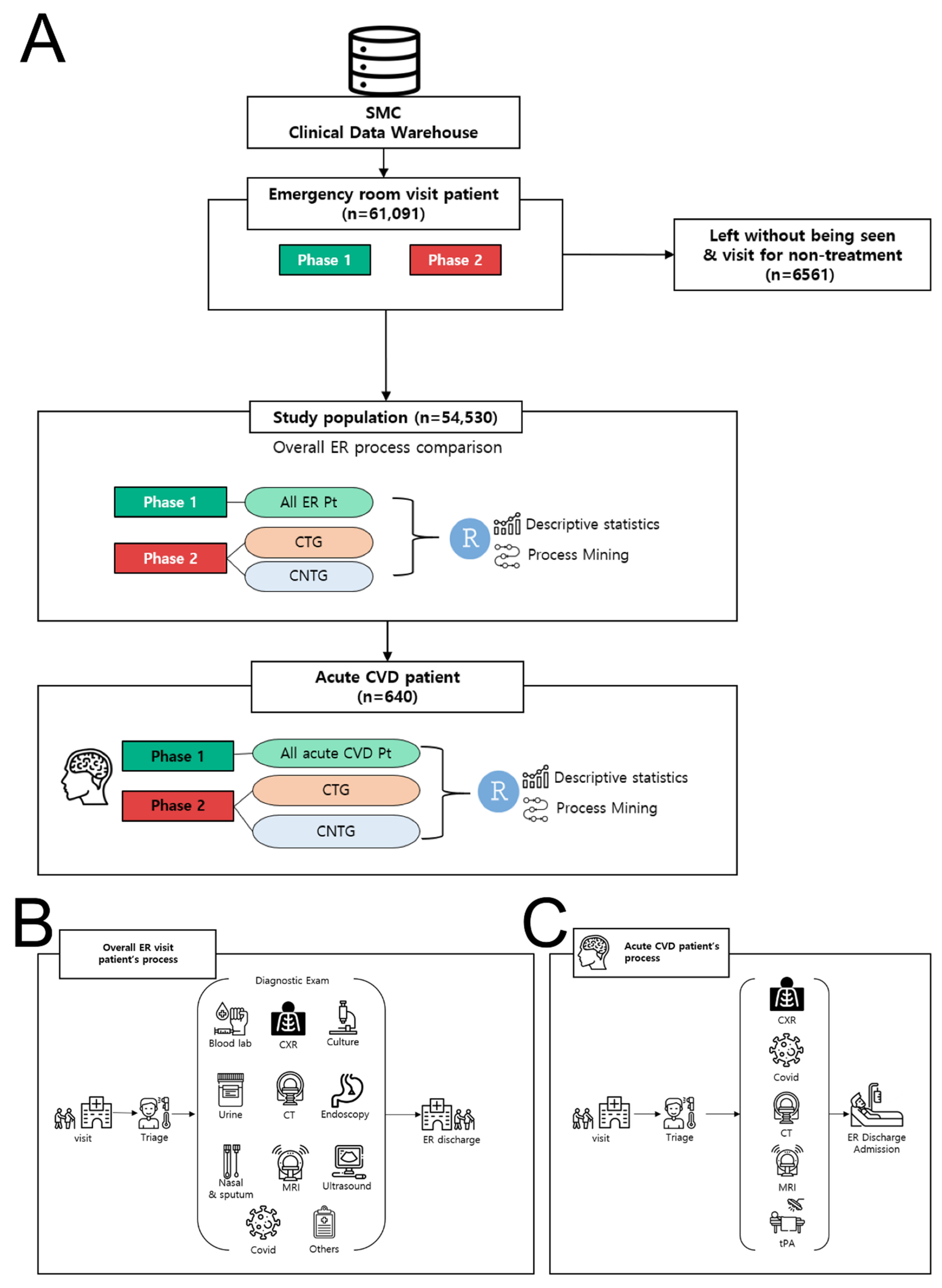
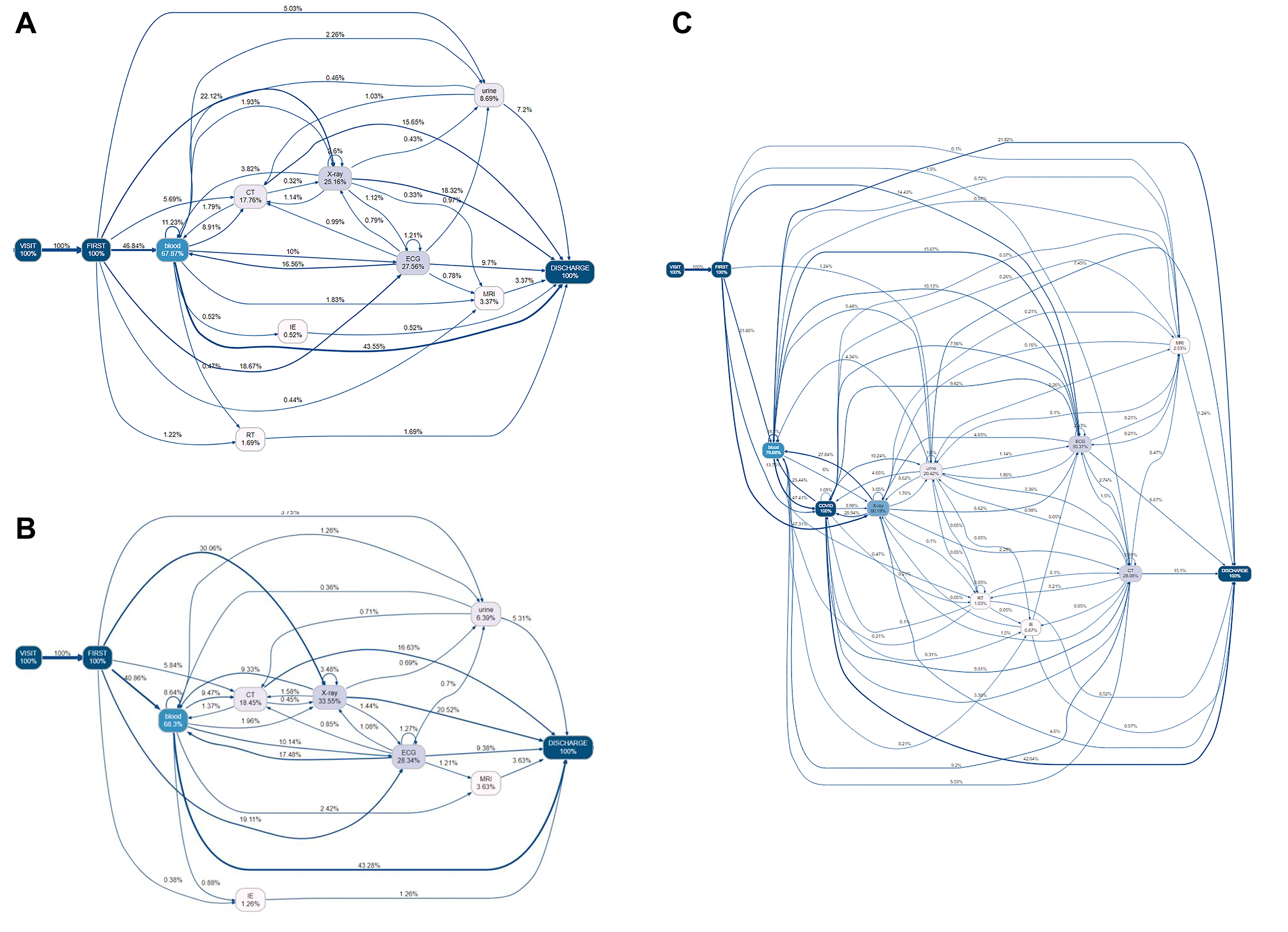
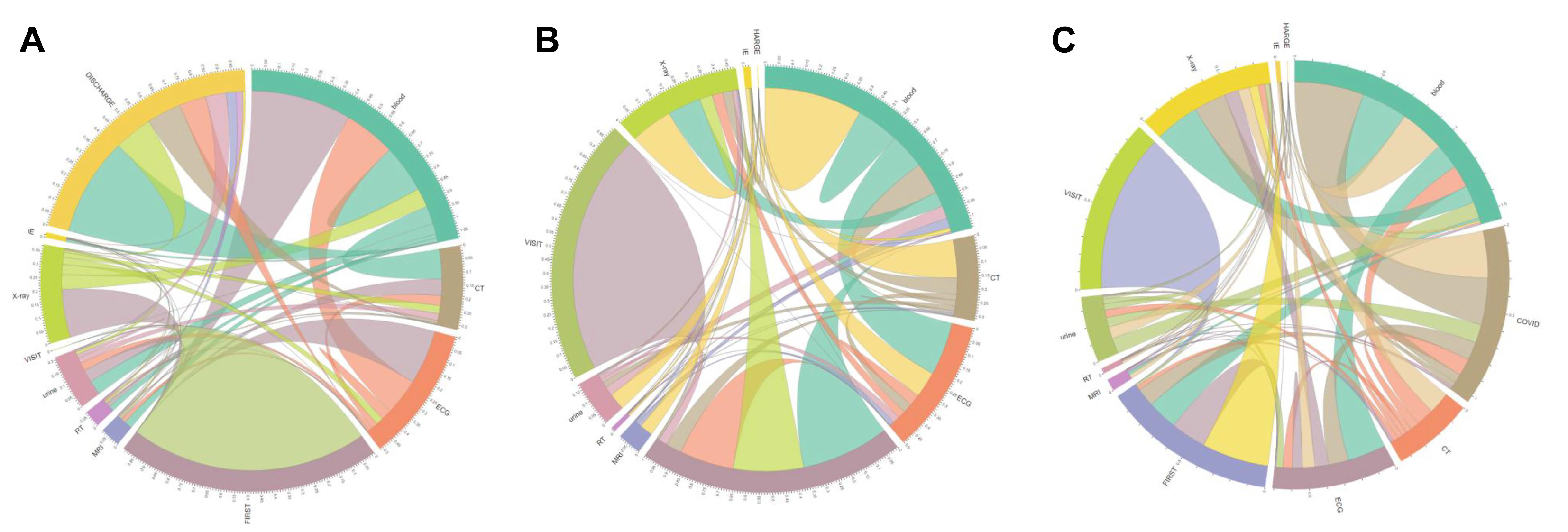
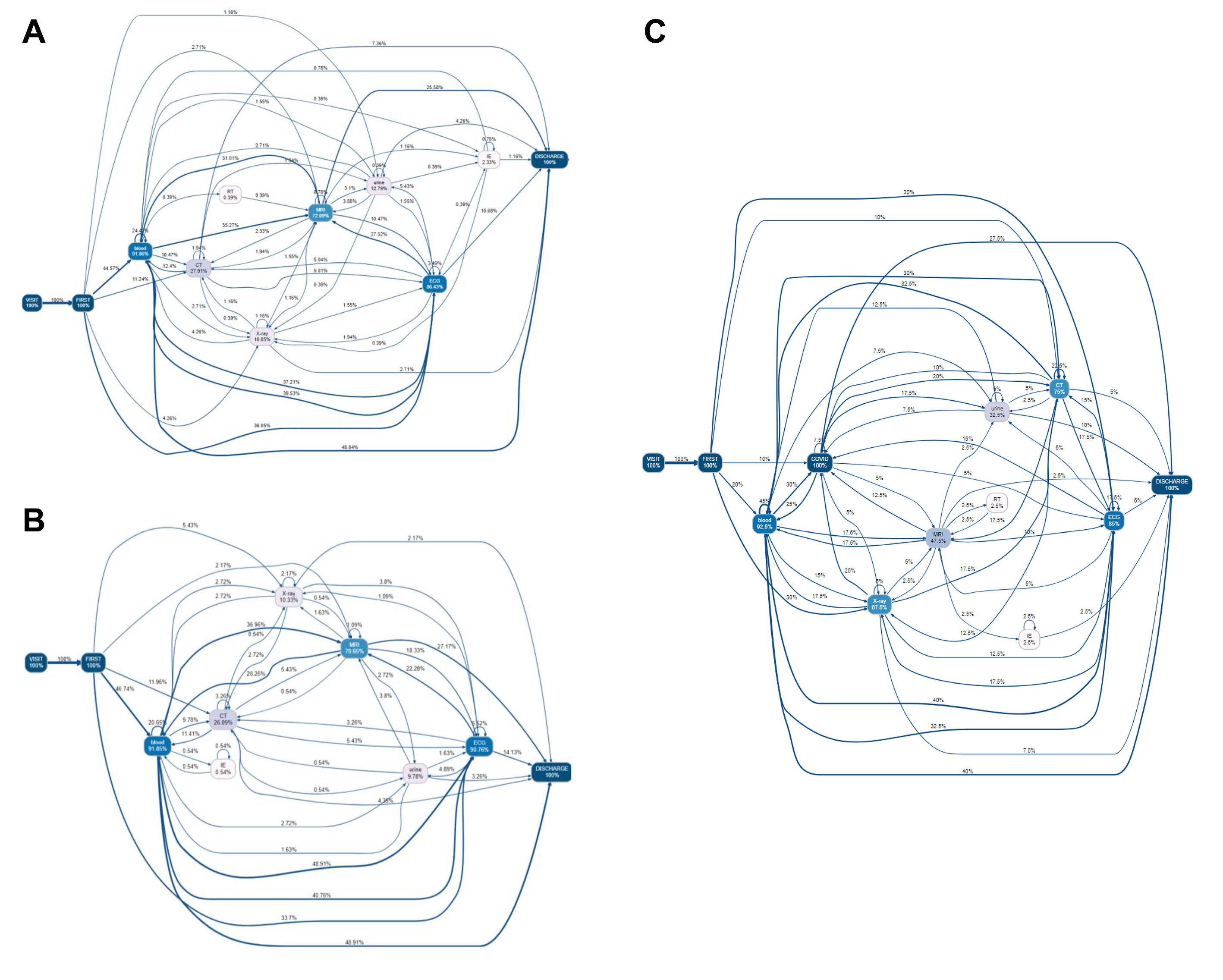
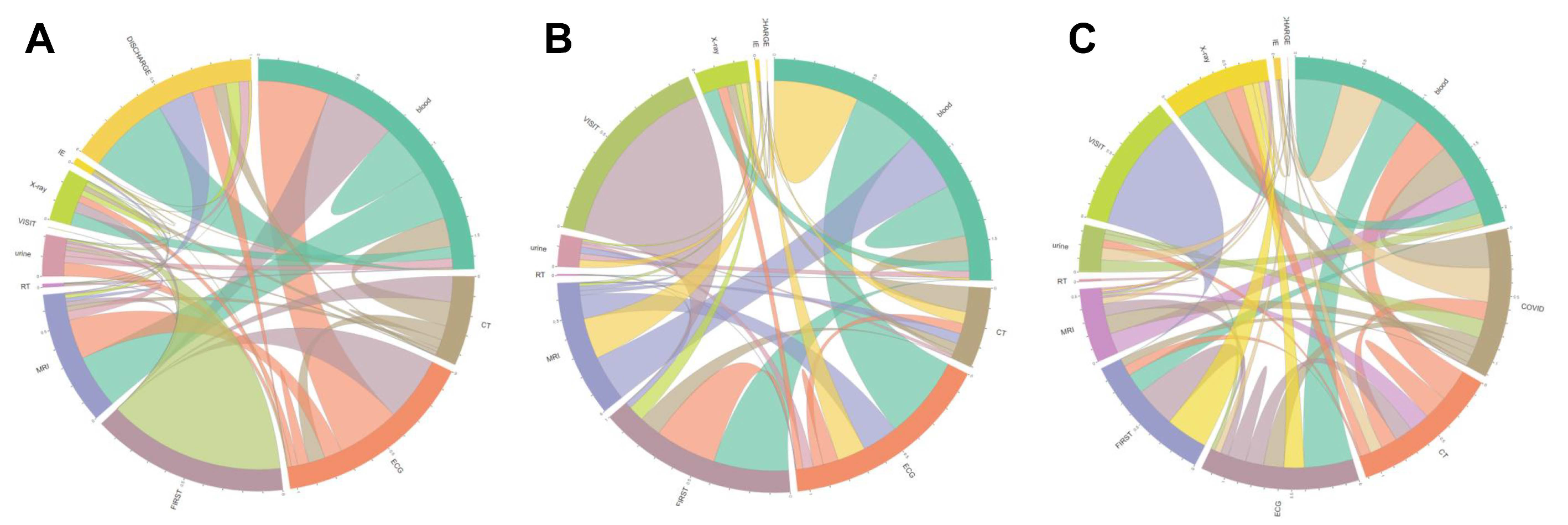
| Phase 1 (n = 31,793) | Phase 2 (n = 22,737) | |||
|---|---|---|---|---|
| CTG (n = 3223) | CNTG (n = 19,514) | p-Value | ||
| Age, median [IQR] | 52 [26;66] | 62 [46;73] | 53 [31;66] | <0.001 |
| Sex, n (%) | <0.001 | |||
| Male | 15,948 (50.2%) | 1716 (53.2%) | 9731 (49.9%) | |
| Female | 15,845 (49.8%) | 1507 (46.8%) | 9783 (50.1%) | |
| SBP (mmHg), median [IQR] | 121 [26;66] | 125 [105;143] | 128 [109;146] | <0.001 |
| DBP (mmHg), median [IQR] | 73 [61;84] | 75 [62;87] | 79 [66;90] | <0.001 |
| PR (beats/min), median [IQR] | 88 [76;104] | 100 [85;116] | 88 [76;102] | <0.001 |
| RR (breaths/min), median [IQR] | 18 [17;20] | 18 [16;20] | 18 [16;19] | <0.001 |
| TEMP (°C), median [IQR] | 36.9 [36.5;37.3] | 37.3 [36.7;37.9] | 36.8 [36.4;37.2] | <0.001 |
| SpO2 (%), median [IQR] | 98 [97;99] | 97 [96;99] | 98 [97;99] | <0.001 |
| KTAS, n (%) | <0.001 | |||
| 1 | 189 (0.6%) | 32 (1.0%) | 70 (0.4%) | |
| 2 | 1662 (5.2%) | 316 (9.8%) | 1049 (5.4%) | |
| 3 | 14,486 (45.6%) | 1723 (53.5%) | 7775 (39.8%) | |
| 4 | 14,207 (44.7%) | 1041 (32.3%) | 9349 (47.9%) | |
| 5 | 1249 (3.9%) | 111 (3.4%) | 1270 (6.5%) | |
| Mental status, n (%) | <0.001 | |||
| Alert | 31,142 (98.0%) | 3056 (94.8%) | 19,183 (98.3%) | |
| Verbal | 259 (0.8%) | 61 (1.9%) | 139 (0.7%) | |
| Pain | 241 (0.8%) | 76 (2.4%) | 121 (0.6%) | |
| Unresponsive | 151 (0.5%) | 30 (0.9%) | 70 (0.4%) | |
| Mode of arrival, n (%) | <0.001 | |||
| Ambulance | 5719 (18.0%) | 858 (26.6%) | 3376 (17.3%) | |
| Other | 26,074 (82.0%) | 2365 (73.4%) | 16,137 (82.7%) | |
| Discharge, n(%) | <0.001 | |||
| Home | 23,377 (73.5%) | 1381 (42.8%) | 14,722 (75.4%) | |
| ED death | 149 (0.5%) | 31 (1.0%) | 76 (0.4%) | |
| Transfer | 1249 (3.9%) | 228 (7.1%) | 456 (2.3%) | |
| Admission | 7018 (22.1%) | 1583 (49.1%) | 4260 (21.8%) | |
| Admission, n (%) | <0.001 | |||
| ICU | 657 (9.3%) | 216 (13.6%) | 312 (7.3%) | |
| GW | 6361 (90.7%) | 1367 (86.4%) | 3948 (92.7%) | |
| Acute cerebrovascular disease | 404 (1.2%) | 60 (1.8%) | 283 (1.4%) | 0.012 |
| a Phase 1 (n = 84,017) | Phase 2 (n = 69,346) | ||||
|---|---|---|---|---|---|
| b CTG (n = 19,116) | c CNTG (n = 50,230) | p-Value | Post-hoc Analysis | ||
| Overall, hours (median, [IQR]) | |||||
| α Visitto Triage | 0.05 [0.02;0.10] | 0.07 [0.03;0.13] | 0.05 [0.02;0.12] | <0.001 | c < a < b |
| Triage to CT | 2.78 [1.40;4.16] | 6.60 [3.24;10.72] | 2.55 [1.27;4.10] | <0.001 | c < a < b |
| Triage to MRI | 4.70 [3.06;6.96] | 12.03 [5.53;15.41] | 4.37 [2.84;6.56] | <0.001 | c < a < b |
| Triage to ECG | 1.32 [0.49;2.95] | 2.52 [0.91;5.19] | 1.26 [0.59;2.68] | <0.001 | a = c < b |
| Triage to X-ray | 0.96 [0.51;2.53] | 2.09 [0.91;5.19] | 1.04 [0.56;2.41] | <0.001 | a < c < b |
| Triage to β blood | 1.77 [1.09;5.85] | 5.15 [2.07;11.68] | 1.71 [1.07;5.16] | <0.001 | c < a < b |
| CT to discharge | 4.39 [2.11;10.53] | 7.59 [3.75;13.74] | 3.67 [1.84;7.65] | <0.001 | c < a < b |
| MRI to discharge | 4.37 [2.26;11.11] | 7.48 [3.84;14.02] | 3.85 [2.01;7.42] | <0.001 | c < a < b |
| ECG to discharge | 4.90 [2.51;10.10] | 9.54 [4.80;16.07] | 4.36 [2.33;8.10] | <0.001 | c < a < b |
| Visit to discharge | 7.77 [4.47;17.12] | 14.76 [8.92;22.24] | 6.98 [4.13;13.28] | <0.001 | c < a < b |
| a Phase 1 (n = 1978) | Phase 2 (n = 1840) | ||||
|---|---|---|---|---|---|
| b CTG (n = 488) | c CNTG (n = 1352) | p-Value | Post-hoc Analysis | ||
| Acute cerebrovascular patients, hours (median, IQR) | |||||
| Visit to triage | 0.05 [0.02;0.10] | 0.05 [0.03;0.12] | 0.05 [0.03;0.13] | <0.001 | a < b = c |
| Triage to CT | 1.04 [0.46;2.91] | 2.44 [1.07;6.71] | 1.01 [0.55;2.08] | <0.001 | a = c < b |
| Triage to MRI | 4.01 [2.63;5.74] | 5.54 [3.73;12.00] | 3.47 [2.30;5.34] | <0.001 | a = c < b |
| Triage to blood | 2.32 [1.08;7.03] | 4.04 [1.29;14.41] | 1.87 [0.90;5.68] | <0.001 | c < a < b |
| CT to discharge | 5.69 [3.10;10.54] | 9.85 [4.03;16.80] | 4.47 [2.88;8.39] | 0.001 | a = c < b |
| MRI to discharge | 5.89 [3.01;11.02] | 9.44 [5.10;12.15] | 4.81 [2.80;7.98] | 0.001 | c < a = b |
| Visit to discharge | 10.28 [6.35;18.68] | 14.15 [9.48;22.83] | 8.82 [5.34;12.45] | <0.001 | c < a < b |
Publisher’s Note: MDPI stays neutral with regard to jurisdictional claims in published maps and institutional affiliations. |
© 2020 by the authors. Licensee MDPI, Basel, Switzerland. This article is an open access article distributed under the terms and conditions of the Creative Commons Attribution (CC BY) license (http://creativecommons.org/licenses/by/4.0/).
Share and Cite
Chang, H.; Yu, J.Y.; Yoon, S.Y.; Hwang, S.Y.; Yoon, H.; Cha, W.C.; Sim, M.S.; Jo, I.J.; Kim, T. Impact of COVID-19 Pandemic on the Overall Diagnostic and Therapeutic Process for Patients of Emergency Department and Those with Acute Cerebrovascular Disease. J. Clin. Med. 2020, 9, 3842. https://doi.org/10.3390/jcm9123842
Chang H, Yu JY, Yoon SY, Hwang SY, Yoon H, Cha WC, Sim MS, Jo IJ, Kim T. Impact of COVID-19 Pandemic on the Overall Diagnostic and Therapeutic Process for Patients of Emergency Department and Those with Acute Cerebrovascular Disease. Journal of Clinical Medicine. 2020; 9(12):3842. https://doi.org/10.3390/jcm9123842
Chicago/Turabian StyleChang, Hansol, Jae Yong Yu, Sun Young Yoon, Sung Yeon Hwang, Hee Yoon, Won Chul Cha, Min Seob Sim, Ik Joon Jo, and Taerim Kim. 2020. "Impact of COVID-19 Pandemic on the Overall Diagnostic and Therapeutic Process for Patients of Emergency Department and Those with Acute Cerebrovascular Disease" Journal of Clinical Medicine 9, no. 12: 3842. https://doi.org/10.3390/jcm9123842
APA StyleChang, H., Yu, J. Y., Yoon, S. Y., Hwang, S. Y., Yoon, H., Cha, W. C., Sim, M. S., Jo, I. J., & Kim, T. (2020). Impact of COVID-19 Pandemic on the Overall Diagnostic and Therapeutic Process for Patients of Emergency Department and Those with Acute Cerebrovascular Disease. Journal of Clinical Medicine, 9(12), 3842. https://doi.org/10.3390/jcm9123842





